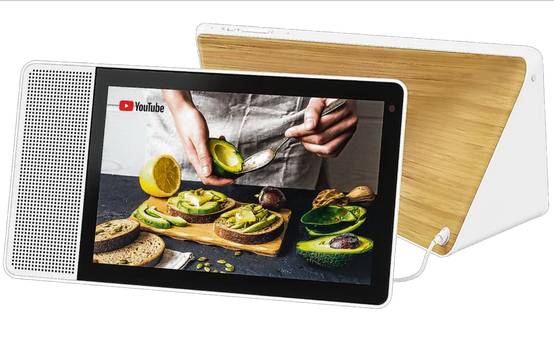I have a few smart speakers throughout the house. So far, the ones with screens are still overwhelmingly used just for audio – the radio, mainly, with some podcasts, timers, news bulletins and Spotify thrown in.
But this is principally because they have small screens, particularly Amazon’s Echo Spot and Echo Show 5.
I’m never really tempted to watch an episode of something on one.
However, the quality of smart screens-cum-speakers is starting to reach a point where they’re demanding closer scrutiny.
It’s against that background that I’ve been testing Lenovo’s new Smart Display, a 10-inch screen on a smart speaker that uses Google’s Assistant and has pretty good audio quality.
Its highlights are that it is more elegantly designed than most other smart speakers or smart screen devices, with a curved, bamboo casing on the back and an alternate, space-saving vertical position if it’s to be used mainly for audio.
It also has a camera on it, in case you want to make video calls to others, although that is limited to Google’s Duo calling system.
As it uses Google’s Assistant, it responds to all of the functionality that your phone would when you say ‘OK Google’.
That means controlling compatible household utilities like lightbulbs and heating, as well as a pretty massive array of information services online.
But you can do that from your phone. The main attraction to a smart screen is being able to summon things to watch on it. Watching YouTube is one advantage that Google-powered smart speakers have over Amazon Echo ones. On Amazon’s devices, you can watch YouTube, but only through the browser. Here, the native app responds to your voice commands.
I’m a YouTube Premium subscriber, so in theory, this should be something that would suit me down to the ground. I did find it useful, in terms of catching up with highlights of a football match or YouTube reviews of things.
But, otherwise, I mainly used it for the audio from YouTube: podcasts (many of which are now videoed), stand-up comedy and other long clips, varying from a few minutes to half an hour.
You can also watch TV shows or movies from Google Play, although not Netflix.
But I haven’t taken to watching things on it in that way. For me, the actual video part of it all has been ‘snackable’ content that I might as easily have watched on my smartphone. (At no point, either, did the family sit around watching the same thing on the Smart Display.)
I’m not sure whether this is something that might change over time. But in the kitchen, I find that the screen I most look at is the phone or tablet, swiping or scrolling through a mixture of entertainment, messages and social media. In other words, in that room, I tend to listen to a show, rather than actively watch it.
One nice effect is that when the screen is sleeping, it can display photos (yours from your Google Photos album or famous ones), or screensavers like a clock (you can choose from different styles).
In general, the Smart Display is a nice addition to the home and I’d happily recommend it. The only thing I was less than impressed by was the comparative audio quality. It’s decent and is generally good enough for a kitchen or a bedroom, especially if it’s mainly speech you’ll listen to on it.
But it’s a notch down from some (cheaper) audio-only devices like Amazon’s Echo Plus, which can even hold a modestly sized living room with fairly rich sound quality.
It may be that the Smart Display doesn’t have as much space to devote to its actual speaker as the Amazon device because of the screen. Even still, given that it costs about €75 more, I’d ideally prefer a slightly better level of audio from it.
Source: Read Full Article
